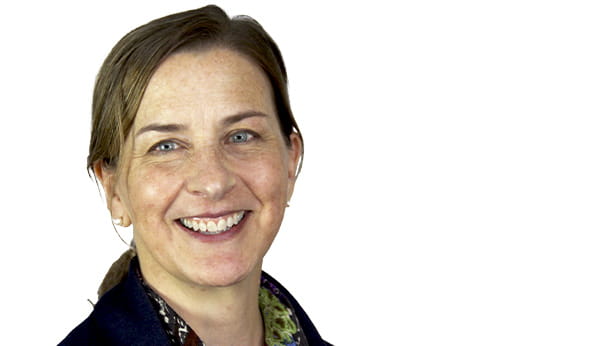In honor of Women’s History Month, Stella Tai, Stewardship Investing Impact and Analysis Manager at Praxis Mutual Funds®, interviewed Lori Scott to reflect on the contributions and achievements of women in the field of investing. Lori Scott

Tell us about your background and how you got into of investment management.
I came to impact investing indirectly. Growing up in Indiana, my mom told us that she was only given three career choices: hairdresser, teacher or nurse. I’m thankful she didn’t want to put the same gendered limits on my sisters and me. I saw college as a way to get out of my economically depressed town. The steel mills had been a major employer and, when they moved offshore, unemployment went up, the tax base went down, and the area struggled. Like many places in the U.S., the neighborhood I grew up in had low rates of upward mobility, and it was even worse when you filter for gender or race.
My first job was at a City of Chicago program that funded artists to bring their work to disinvested neighborhoods. Over and over, I saw the power of arts to engage people, create community, preserve culture and enrich lives. This sparked my interest in community development, and I went back to get my MBA with the vague notion that business skills could be used for good purposes. At that time, the percentage of women in MBA programs was less than a third, and although that number has since increased, it remains well below fifty percent.
After business school, I became a real estate lender at Illinois Facilities Fund, a community development finance institution, making loans to nonprofit social service facilities, like childcare centers. These loans allowed local nonprofits to buy their buildings and improve their balance sheets. That was my first lesson in how traditional financial tools could be creatively redesigned and used for social change. For decades now, CDFIs have shown how to build healthy portfolios and generate a consistent yield, while making capital available where mainstream financing was not available.
Why was a focus on underserved women, people and places important to you?
Reimagining how capital can be used to solve problems is what drew me to this work. Impact investing can be used as a tool to realize human potential by re-channeling capital to support quality basic goods and services, like quality healthcare, affordable housing and quality jobs. It is a tool for making systemic changes by supporting women and diverse entrepreneurs and fund managers, that will further shift capital to underserved people and places and make strides to bridge the wealth gap.
What are your current views on the state of gender-lens investing?
When I first joined Calvert Impact, our investment strategy was centered on community development and affordable housing in the U.S. and microfinance internationally. I first learned about gender lens investing through Calvert’s microfinance work. As many of the early microfinance models focused on women. it demonstrated that very poor women around the world were a good credit.
There is so much inspiring work going on right now in gender-lens investing, with a global blossoming of talent pioneering innovative investment strategies and contributing to thought leadership, research, and data. There has been an uptick in diverse voices in the gender conversation, an overdue improvement. Despite the vibrancy in the gender lens investing conversation, it is curious that there are conflicting reports on the amount of assets explicitly dedicated to the strategy. The 2X Challenge, launched at the G7 Summit in 2018 to encourage more investment in women, reports that there was $11.4 B in total committed and mobilized investments in 20201. However, a surprisingly low data point is that only 1% of sustainable bonds have been tied to Gender Equality SDG 5, according to Moody’s.
As a practitioner-investor, I look to the experts in the field to learn, like Suzanne Biegel, founder of Gender Smart, convener, educator, and thought leader on gender investment strategies. Another resource is the Global Impact Investment Network’s Gender Lens Investing Initiative that was created to support impact investors to integrate a gender lens investment strategy into their portfolios. There are also many inspirational leaders in the field whose work demonstrates gender lens investing success like Durreen Shahnaz, founder of Impact Investment Exchange (IIX), who recently launched their ninth Women’s Livelihood Bond, an impact investment at the intersection of gender and climate that seeks to improve livelihoods of women across Asia-Pacific and Africa. IIX also offers a range of resources in addition to investment products, like impact measurement tools. Here in the U.S., Charisse Conanan Johnson, Co-CEO at Next Street, is an expert on investment strategies to support diverse entrepreneurs, and also a personal finance expert, and recently published “A Wealthy Girl,” that advises on culturally inclusive wealth building.
What would you say to those who are still concerned about the perceived risk of this kind of investing?
When we talk about risk, it’s important to unpack the assumptions that are underpinning the assessment and be aware of perceived risks. What data, if any, is informing the risk aversion? This is a fertile time for experimentation with investment to create change, and in parallel, there are rapid advancements in impact data collection and interpretation.
There is compelling performance data for gender lens investing. Patience Marime-Ball and Ruth Shaber detail this in their recent book The XX Edge: Unlocking Higher Returns and Lower Risk about how incorporating diverse decision makers in addition to gender-lens investment strategy can lead to more attractive returns. They describe how new companies led by women perform 63% better than those led by men over a 10-year period. At the decision-making level, gender diverse teams are 21% more likely to see outperformance in profitability over those led exclusively by men. Goldman Sachs reported that female-managed U.S. funds outperform all-male rivals based on their analysis of 496 large-cap U.S. equity funds with combined assets of $2.3tn2. That is a taste of the compelling data supporting a gender-lens approach.
There is a broad range of impact investment products available for people all along the risk spectrum, in different asset classes, geographies, sectors, and impacts. Some strategies require capital that has more modest return expectations — or objectively has higher risk — to achieve a certain outcome.
What are some of the advances that you have seen in making the investment management field more diverse by attracting more women, including women of color?
Bringing diversity to all levels of decision making is critical to addressing the systemic barriers that result in unequal access to resources for women. Women were hired into only 37% leadership roles in 20223, and women hold just 29% of board seats4. Something is amiss since a higher proportion of women on boards is correlated with higher credit ratings, according to Moody’s Investors Service5.
Additionally, in 2022, women founded start-ups raised 1.9% of all venture capital funds6, only about 12% of decision makers at venture capital firms are women, and 65% of firms do not have a single female partner7. When you layer in race, the numbers plummet further. For example, less than 1% of U.S. venture firms are led by Black women and 0.3% of U.S. venture capital goes to Black-women-owned businesses.
These appalling numbers show the urgent need to increase women’s participation. When this is combined with the data that shows increasing participation of women improves performance. Until we fix this, everyone loses.
There are many excellent programs designed to bring more women and diverse people into the field. For example, the Toigo Foundation identifies and develops the next generation of diverse investment leaders and an impressive roster of impact investment leaders have come through that program. Forte Foundation works to increase women in leadership starting with increasing women’s enrollment in MBA programs. Here in Chicago, I’ve recently joined Women Investment Professionals which has networking and educational events for women in the financial services industry.
While the general statistics of women in leadership are grim, I’ve been privileged to work for and learn from several amazing women leaders in this field: Trinita Logue, founder of IFF; Shari Berenbach, Lori Chatman and Lisa Hall at Calvert Impact, and again with Lisa at Anthos, a family office in the Netherlands, and with Debra Schwartz, at MacArthur Foundation.
The firm where I work now, Lafayette Square, has about half women and half people of color on staff and its feels like I’ve landed in the bright future of equal opportunity.
Why should we continue to focus on the issue of women in investing even as progress is being made?
So, much work remains to be done. According to the World Economic Forum’s Global Gender Gap report 20228, it will take another 132 years to close the global gender gap. The pandemic further increased pressures on women globally due, in part, to increased caregiving responsibilities. I don’t think we fully understand these effects on slowing the progress to reach gender parity. Adding the lens of race, ethnicity, and/or location, these statistics become even more stark, and the need for tailored strategies is urgent.
The gender gap is also expensive. By eliminating the global gender gap, the McKinsey Global Institute estimates that the world economy could gain up to U.S. $28 trillion — an additional 26% — to the annual global gross domestic product in 20259. Conversely, this statistic demonstrates that there is a lot of value available to unlock by shifting capital more equitably.
I do think we are in the very early days of gender lens investing, and for impact investing, for that matter, even though these strategies have been around for decades. There is incredible potential to scale successful strategies, and plenty of room to innovate new impactful investment strategies. That sense of possibility is what motivates me. At the MacArthur Foundation, and now at Lafayette Square, I’ve been focused on how to scale impact investment strategies so that more people benefit from the myriad of proven solutions.
You have a long history working with Praxis Mutual Funds as a partner in our work in community development investing and now as a new member of our Board of Trustees. What thoughts would you have about your experience with Praxis?
25 years ago, when Praxis Mutual Funds decided to dedicate about 1% to community investments, it was rare for sustainable investing to go beyond screening. It was a genuine expression of its faith-based values. As pioneers in the space, I’m inspired by the unwavering commitment to aligning its values with its financing products. I’m honored to serve on the Board of Trustees.
What wisdom or challenge can you leave us with?
Be curious and listen more, especially to the people that you are intending to help!
Praxis Mutual Funds pursues diversity and inclusion not just at its own board table, but also throughout its investing and shareholder advocacy activities. Addressing inequality in corporations is one of Praxis’ two primary shareholder advocacy objectives for the next several years. This effort is supported by an active proxy voting strategy that emphasizes diversity and inclusion on the boards of the companies in which Praxis invests. We believe that the inclusion of diverse voices at the board table leads to better outcomes.
Praxis Mutual Funds is privileged to work with many talented women including Praxis Trustees Lori Scott, Aimee Minnich and Laura Berry.

